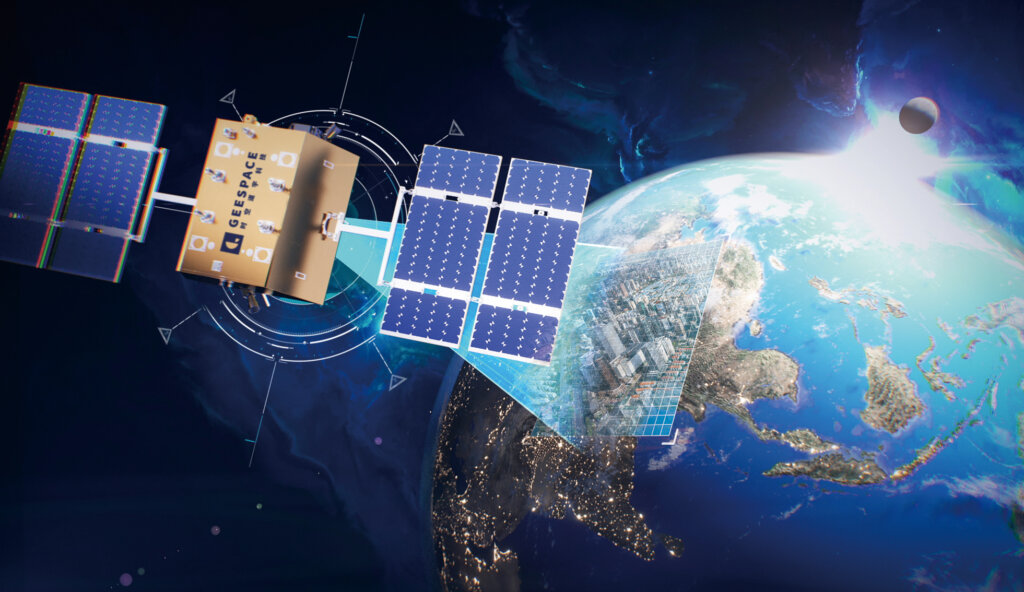
Autonomous vehicles rely heavily on LEOs for their operation. (Image – Geely)
Why LEO satellites are essential for autonomous vehicles
- Chinese carmaker Geely has launched another 11 LEO satellites.
- LEO satellites are satellites that orbit the Earth at a low altitude.
- Several carmakers have been designing their own LEO satellites.
Low-earth orbit (LEO) satellites are satellites that orbit the Earth at a low altitude, usually between 200 and 2,000 km above the Earth’s surface. They are used for applications inluding communication, navigation, remote sensing, and scientific research.
According to the satellite tracking website Orbiting Now, there are currently 8,377 LEO satellites orbiting around the Earth. The US dominates the number of satellites with 2296 LEOs in orbit while China comes in a distant second with 493 LEOs, followed by the UK with 450.
LEO satellites are much smaller in size than either MEO or GEO satellites. That means they are correspondingly more affordable to build and deploy – which explains their profusion.
The European Space Agency says that unlike satellites in GEO, that must always orbit along Earth’s equator, LEO satellites do not always have to follow a particular path around Earth in the same way – their plane can be tilted. This means there are more available routes for satellites in LEO, which is one of the reasons why LEO is a very commonly used orbit.
It is also important to note that individual LEO satellites are less useful for tasks such as telecommunication because they move fast across the sky, and therefore require a lot of effort to track from ground stations. Instead, communications satellites in LEO often work as part of a large combination or constellation of multiple satellites to give constant coverage.
The advantages of LEO satellites include their ability to provide faster and more reliable internet access to remote and rural areas, as they have lower latency and higher bandwidth than traditional satellites. LEOs are also cheaper and easier to launch and maintain, as they require less energy and fuel to reach their orbit and can be replaced more frequently. LEOs can also cover more areas of the Earth’s surface, as they have a wider field of view and can operate in constellations of multiple satellites.
Some examples of LEO satellite providers are:
- SpaceX: SpaceX is a private aerospace company owned by Elon Musk that aims to provide broadband internet access to underserved areas through its Starlink constellation. There are currently over 5289 SpaceX satellites in orbit, with plans to extend the number to 42,000.
- OneWeb: OneWeb is a global communications company that plans to deploy a network of 648 LEO satellites to deliver high-speed, low-latency internet services to remote regions.
- Telesat: Telesat is a Canadian satellite operator that is developing a LEO network called Telesat Lightspeed, which will consist of 198 LEO satellites with advanced features such as optical inter-satellite links and phased array antennas.
- Amazon: Amazon’s Project Kuiper System is planned to consist of 3,236 satellites operating in 98 orbital planes in three orbital shells. In October 2023, two prototype satellites were launched. After demonstrating 100 Gbps optical links between its prototype satellites, Project Kuiper will include laser links on every satellite in its constellation to form a mesh network in space.

LEOs’ close proximity to Earth makes them useful for several reasons. (Source – European Space Agency).
LEO satellites for autonomous vehicles
While there are several use cases for LEO satellites, autonomous vehicles rely heavily on them. For one thing, low latency is paramount for autonomous vehicles and LEO satellites have the potential to provide a signal latency of less than 10ms. This is crucial for autonomous vehicles that depend on real-time data to make safe decisions.
LEO satellites can also offer higher bandwidth than satellites in higher orbits, which lets autonomous vehicles access large amounts of data, such as maps, traffic, weather, and software updates. This feature is a prerogative for self-driving vehicles.
When it comes to global coverage, LEO satellites can provide ubiquitous connectivity to autonomous vehicles, even in remote or rural areas where cellular networks may be unavailable or unreliable.
Despite several LEO satellite providers in the industry, several carmakers have also been designing their own LEO satellites, specific to the needs of their own fleets. Some examples of vehicle manufacturers operating LEO satellites include Tesla, Toyota, Hyundai, and Volvo.
Chinese carmaker Geely has also been producing its own satellites. Having launched its first set of LEO satellites in 2022, the Chinese automaker recently launched another 11 LEOs. The second dispatch expands Geely’s capacity to provide more accurate navigation for autonomous vehicles.
According to a report by Reuters, the satellites were launched from the Xichang Satellite Launch Center in the southwestern province of Sichuan. Geely said it expects 72 to be in orbit by 2025 and eventually plans to have a constellation of 240.
China’s satellite networks are dominated by its military, but the government began to allow private investment in the country’s space industry in 2014. Since then, commercial companies, some backed by local governments, have rushed into the sector, with the majority focusing on making satellites and the rest attempting to build small launch vehicles including reusable rockets.

LEO satellites are much smaller than MEO and GEO satellites, meaning they’re easier and cheaper to build and launch. (Image – Geely).
Increasing satellites a concern?
While LEO satellites have been a game-changer in use cases, their growing number in space has created some concern. First, there are concerns about the amount of space junk that will remain in space once these satellites are no longer functional.
For example, the Starlink satellites by SpaceX only have a lifespan of up to seven years before being decommissioned. But they will take 15 to 20 years to decay and burn up in the atmosphere – spending at least twice their operational lifespan as space junk.
Apart from space junk, another big concern is the satellites being used for espionage and spying purposes. Geely’s latest launch of satellites will definitely be on the radar of the US. While the satellites are not designed for spying, they are capable of sending data back, which could be concerning to some.
At a recent Space Mobility Conference, topics discussed included concerns by the US Space Force over China ramping up its constellation of reconnaissance satellites. China’s latest launches of optical and radar surveillance spacecraft have some US officials dismissing China’s claims that these satellites were focused more on civilian and commercial use cases.
China’s five-year plan for 2021-2025 calls for a comprehensive satellite network for communications, remote sensing, and navigation. The project Geely launched on satellites exhibits China’s increasing innovation in the space industry. It indicates how the boundaries between the automotive and space sectors are fading as both aim to use the capabilities of AI and connectivity.
READ MORE
- Safer Automation: How Sophic and Firmus Succeeded in Malaysia with MDEC’s Support
- Privilege granted, not gained: Intelligent authorization for enhanced infrastructure productivity
- Low-Code produces the Proof-of-Possibilities
- New Wearables Enable Staff to Work Faster and Safer
- Experts weigh in on Oracle’s departure from adland




